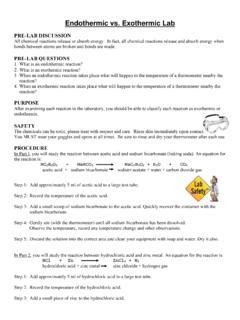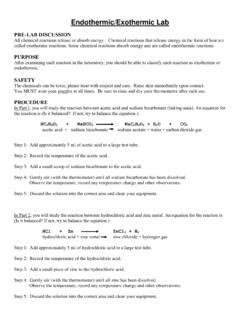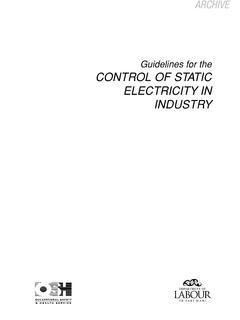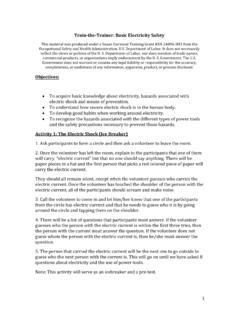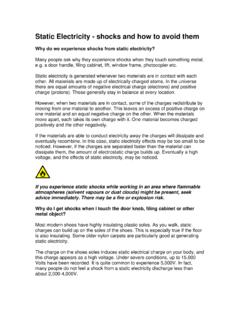Transcription of Materials that Cause Static Electricity
1 Materials that Cause Static Electricity Some Materials Cause or create more Static Electricity than others. Since Static Electricity is the collection of electrically charged particles on the surface of a material, various Materials have a tendency of either giving up electrons and becoming positive (+) in charge or attracting electrons and becoming negative ( ) in charge. The Triboelectric Series is a list of Materials , showing which have a greater tendency to become positive (+) and which have a greater tendency to become negative ( ). The list is a handy tool to determine which combinations of Materials create the most Static Electricity . Questions you may have include: What are Materials in the Triboelectric Series? What are the best combinations of Materials ? What are acceptable combinations? Triboelectric Series Common Materials are listed according how well they create Static Electricity when rubbed with another material, as well as what charge the material will possess.
2 Become positive in charge The following Materials will tend to give up electrons when brought in contact with other Materials . They are listed from those with the greatest tendency to give electrons to those that barely give up electrons. Materials that gain a positive (+) electrical charge (or tend to give up electrons) Dry human skin Greatest tendency to giving up electrons and becoming highly positive (+) in charge Leather Rabbit fur Fur is often used to create Static Electricity Glass The glass on your TV screen gets charged and collects dust Human hair "Flyaway hair" is a good example of having a moderate positive (+) charge Nylon Wool Lead A surprise that lead would collect as much Static Electricity as cat fur Cat fur Silk Aluminum Gives up some electrons Paper Neutral There are very few Materials that do not tend to readily attract or give up electrons when brought in contact or rubbed with other Materials . Materials that are relatively neutral Cotton Best for non- Static clothes Steel Not useful for Static Electricity Become negative in charge The following Materials will tend to attract electrons when brought in contact with other Materials .
3 They are listed from those with the least tendency to attract electrons to those that readily attract. Best Combinations The best combinations of Materials to create Static Electricity would be one from the positive charge list and one from the negative charge list. Skin and polyester clothes A common complaint people have in the winter is that they shoot sparks when touching objects. This is typically caused because they have dry skin, which can become highly positive (+) in charge, especially when the clothes they wear are made of polyester material, which can become negative ( ) in charge. People that build up Static charges due to dry skin are advised to wear all-cotton clothes, which is neutral. Also, moist skin reduces the collection of charges. Combing your hair Human hair becomes positive (+) in charge when combed. A hard rubber or plastic comb will collect negative ( ) charges on its surface. Since similar charges repel, the hair strands will push away from each other, especially if the hair is very dry.
4 This is called "flyaway" hair. Since the comb is negatively charged, it will attract object with a positive charge like hair. It will also even attract material with no charge like small pieces of paper. Fur and plexiglass rod Rubbing a plexiglass rod with rabbit fur or wool will give the rod a negative charge. Although the rod can be used to pick up scraps of paper, the fur and wool quickly lose their charge. Materials that gain a negative ( ) electrical charge (Tend to attract electrons) Wood Attracts some electrons, but is almost neutral Amber Hard rubber Some combs are made of hard rubber Nickel, Copper Copper brushes used in Wimshurst electrostatic generator Brass, Silver Gold, Platinum It is surprising that these metals attract electrons almost as much as polyester Polyester Clothes have Static cling Styrene (Styrofoam) Packing material seems to stick to everything Saran Wrap You can see how Saran Wrap will stick to things Polyurethane Polyethylene (like Scotch Tape) Pull Scotch Tape off surface and it will become charged Polypropylene Vinyl (PVC) Many electrons will collect on PVC surface Silicon Teflon Greatest tendency of gathering electrons on its surface and becoming highly negative ( )
5 In charge Moderate combinations When two Materials that tend to give up electrons are rubbed together, the one with the greatest tendency will moderately become positive (+) in charge. Likewise, when two Materials that tend to attract electrons are rubbed together, the one with the greatest tendency will moderately become negative ( ) in charge. Silk and glass Rubbing a glass rod with a silk cloth will charge the glass with positive charges. The silk does not retain any charges for long. Saran Wrap Unrolling a piece of Saran Wrap or similar plastic wrap creates negative charges on the sheet. It will tend to stick to neutral items. Summary Various Materials have a tendency of either giving up electrons and becoming positive (+) in charge or attracting electrons and becoming negative ( ) in charge. The Triboelectric Series is a list of Materials , showing the relative tendency to become charged. This list can be used to determine which combinations of Materials create the most Static Electricity .
6 Check your understanding. 1. What happens to a material that collects electrons on its surface? A) It has a negative charge. B) It has a positive charge. C) It shoots off sparks. 2. Rubbing which Materials together would produce the most Static Electricity ? A) Nylon and Teflon B) Dry skin and cat fur C) Wood and paper 3. If you combed your hair with a plastic comb, which would give up its electrons? A) Your hair B) The comb C) Your skin, if it was dry 4. If you used a silk cloth to polish your hard wood floor, the silk cloth would become A) Negatively charged B) Positively charged D) Neutral 5. Static Electricity is formed much better when the A) air is dry. B) humidity is high. 6. If you rub a balloon on your head, which would gain extra electrons? A) The balloon B) Your hair C) The air around you 7. What do your clothes have to do with getting shocks? A) Certain colored clothes attract Static Electricity .
7 B) Wearing clothes causes Static Electricity . C) Certain Materials rubbing against your skin Cause Static Electricity 8. What is a major Cause of getting Static Electricity shocks? A) Buildup of charges due to dry skin rubbing on clothes. B) Sitting too close to the television set. C) Walking barefoot on an old carpet. 9. If you wear a cap and are having problems with Static cling, what type of material would be your last choice (you are trying to prevent Static cling)? A) Silk B) Polyester C) Cotton D) Nylon Triboelectric Series The process of electron transfer as a result of two objects coming into contact with each other and then separating is known as 'triboelectric charging'. The prefix 'tribo' means 'to rub.' The process of triboelectric charging results in one object gaining electrons on its surface, and therefore becoming negatively charged, and another object losing electrons from its surface, and therefore becoming positively charged.
8 Most Positive (+) Air +++ + Human Hands, Skin Asbestos Rabbit Fur Glass Human Hair Mica Nylon Wool Lead Cat Fur Silk Aluminum Paper Cotton Steel - - - - Wood Lucite Sealing Wax Amber Rubber Balloon Hard Rubber Mylar Nickel Copper Silver uv Resist Brass Synthetic Rubber Gold, Platinum Sulfur Acetate, Rayon Polyester Celluloid Polystyrene Orlon, Acrylic Cellophane Tape Polyvinylidene chloride (Saran) Polyurethane Polyethylene Polypropylene Polyvinylchloride (Vinyl) Kel-F (PCTFE) Silicon Teflon Silicone Rubber Most Negative (-)


